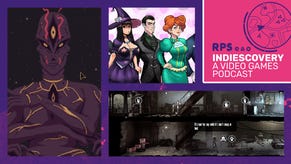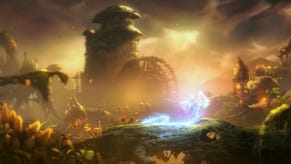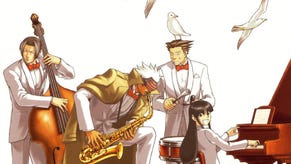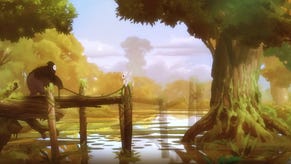Wot I Think: Ori And The Blind Forest
Ocarino Echoes
Ori and the Blind Forest [official site] is a beautiful game. That's the first thing you'll notice. The extended intro sequence plays out like a vaguely interactive Studio Ghibli animation as your character - a glowing mouse-like guardian spirit called Ori - is cared for by adopted bear-like parent Naru after she falls into the forest from the Spirit Tree. The animation is luxurious as Ori perches on Naru's shoulders as they seek apples and while the pair build a bridge over a pool. It's the first cut scene in a long time where I've sat back and watched rather than mash buttons in order to move the action along.
As the intro draws to a close the story and the forest darken. A gigantic angry-looking owl has disturbed the natural order of things, ripping the light from the woods and from the Spirit Tree which cares for the area. It's at this point that the game proper begins with Ori stranded in a tangled wilderness, needing to heal or repair the damage to the land.
From this point you'll find a tight, polished Metroidvania-style platformer with echoes of Ocarina of Time.
In the early stages of the game Ori picks up a helpful ball of light sent out by the Spirit Tree called Sein. She offers helpful information at various points as well as some utility by providing your attack options. At this early stage Ori's own small skill set consists of running and jumping and launching bursts of autotargetted projectiles via Sein in a small range around her.
It's a skill set which gradually evolves as you encounter the memorial trees for those who have died. One bequeaths the knowledge of how to double jump, another offers wall-climbing. In order to improve these basic skills there's also a three-pronged skill tree where you can spend ability points (accrued by collecting the yellow light globules enemies drop on death and yellow orbs hidden around the map). In doing so you can improve Ori's damage-dealing capabilities as well as adding health regeneration options, underwater breathing and so on.
The game revolves around chains of action which exploit your current skillset. None of that skillset will be unfamiliar to a player of platform games but for all their familiarity they are at least well-executed. In the regular world map these chains might be relatively short; perhaps bouncing your way up a wall while dodging foes and spiked tumbleweed. In these sections there is generally plenty of safe space in which to assess the next challenge.
These spaces can also be used to conjure a soul link. Soul links are mobile save points created by expending energy - blue orbs of light. If you die you'll respawn at your most recent soul link or at the game's predefined save points. The latter are few and far between so you'll soon fall into the habit of creating soul links at regular intervals. Or threatening to throw your PC into the nearest duck pond because you forgot to do that and now have to redo an entire section.
In particular areas which Ori is trying to repair or cleanse, the chains of action become longer and more challenging. You might also get extra tools to carry which affect how you move and which of your skills are available to you at any point. You'll go further between possible save points (I grew to loathe the warning that I couldn't create a soul link on unsafe ground or with enemies nearby) and experience the frustration of limited energy resources.
This action chaining reaches its peak in several sections where you're running to avoid something deadly. There are no checkpoints and death is instant meaning you'll likely bash your head against those segments for a while until you've learned the finger choreography required.
Run run run jump double jump gliiiiiide run run run powerjump gliiiiide DEATH
Run run run jump double jump gliiiiiide run run run powerjump gliiiiide DEATH
Run run run jump jump DEATH
Run run run jump double jump gliiiiiide run run run double jump gliiiiide smash jump run run run...
If I hadn't been reviewing it I would have stopped playing at one particular point and gone for a soothing trip to the aforementioned local duck pond.
But while it's frequently frustrating it tends to feel like it's your fault rather than the game's. You're the one who budgeted your energy badly and put a soul link in a stupid place, you're the one who couldn't press the button to launch yourself off an enemy projectile fast enough, you're the one who got overconfident after levelling up your damage and died from a frog jumping on your head. Success is a relief every time but it's the sort of relief of a tension headache abating or every muscle in your hands (and one in your cheek just below your right eye) unclenching.
Throughout all of this is the lovely music, the gorgeous artwork and a moving story. That intro sequence brought a lump to my throat, but I wasn't sure whether the game would be able to sustain that ability to be affecting once it became less cinematic. But as the story plays out and I completed tasks I was fed more snippets. The game gradually reveals what's behind the tragedy of the forest and that emotional facet is unspoilt by unforgiving and unadventurous mechanical requirements.
Despite a torrent of swearwords spilling from my face over the final section of play, the story's conclusion instantly brought that lump back to my throat.











